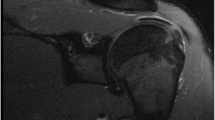Abstract
Background
The aim was to evaluate if concomitant injury to the rotator cuff is important for functional outcome in proximal humerus fractures, and to relate loss of function to malunion of the fractures.
Materials and methods
A total of 76 patients treated conservatively for proximal humerus fracture were included in this cohort study. Performing an MRI examination at the time of injury and after 12 months, tears of the rotator cuffs were classified as partial- or full thickness. The fractures were classified, according to the AO classification, and the degree of tubercle displacement and humeral head inclination evaluated at 12 months. Constant score was used as outcome measure.
Results
Magnetic resonance imaging (MRI) examinations confirmed 22 rotator cuff tears (four full thicknesses) diagnosed at the time of injury, and 10 additional tears (three full thicknesses) at one year. Functional loss at one year significantly corresponded to the tears at the time of injury (P = 0.004), varus malunion of the head and displacement of tubercles (P < 0.001).
Interpretation
Partial- as well as full thickness tears of the rotator cuff are important for functional outcome. Skeletal deterioration seems even more important.



Similar content being viewed by others
References
Audigè L, Bhandari M, Kellam J (2004) How reliable are reliability studies of fracture classifications? A systematic review of their methodologies. Acta Orthop Scand 75(2):184–194
Bertoft ES, Lundh I, Ringquist I (1984) Physiotherapy after fracture of the proximal end of the humerus. Scand J Rehabil Med 16:11–16
Budoff JE (2006) Arthroscopic rotator cuff debridement. Tech Shoulder Elbow Surg 7(1):7–12
Cofield RH (1988) Comminuted fractures of the proximal humerus. Clin Orthop 230:49–57
Constant CR, Murley AHG (1987) A clinical method of functional assessment of the shoulder. Clin Othop 214:160–164
Court-Brown CM, Garg A, McQueen MM (2001) The epidemiology of proximal humeral fractures. Acta Orthop Scand 72(4):365–371
Court-Brown CM, McQueen MM (2004) The impacted varus (A2.2) proximal humeral fracture: prediction of outcome and results of nonoperative treatment in 99 patients. Acta Orthop Scand 75(6):736–740
Gaebler C, McQueen MM, Court-Brown C (2003) Minimally displaced proximal humeral fractures: epidemiology and outcome in 507 cases. Acta Orthop Scand 74(5):580–585
Gallo RA, Sciulli R, Daffner RH et al (2007) Defining the relationship between rotator cuff injury and proximal humerus fractures. Clin Orthop 458:70–77
Hodgson S, Iannotti J, Evans P (2006) Proximal humerus fracture rehabilitation. Clin Orthop 44(2):131–138
Müller ME, Nazarian S, Koch P (1990) The comprehensive classification of fractures of long bone. Springer, New York
Nanda R, Goodschild L, Gamble A, Campbell R, Rangan A (2007) Does the presence of a full-thickness rotator cuff tear influence outcome after proximal humeral fractures? J Trauma 62:1436–1439
Potter HG, Birchansky SB (2005) Magnetic resonance imaging of the shoulder: a tailored approach. Tech Shoulder Elbow Surg 6(1):43–56
Schneider T, Schmidt-Wiethoff R, Drescher W, Fink B, Schmidt J, Apell HJ (2003) The significance of subacromial arthrography to verify partial bursal-side rotator cuff ruptures. Arch Orthop Trauma Surg 123:481–484
Siebenrock KA, Gerber C (1993) The reproducibility of classification of fractures of the proximal end of the humerus. J Bone Joint Surg Am 75-A(12):1751–1755
Teefey SA, Rubin DA, Middleton WD, Hildebolt CF, Leibold RA, Yamaguchi K (2004) Detection and quantification of rotator cuff tears. Comparison of ultrasonographic, magnetic resonance imaging and arthroscopic findings in seventy-one consecutive cases. J Bone Joint Surg Am 86:708–716
Thomazeau H, Rollan Y, Lucas C, Duval JM, Langlais F (1996) Atrophy of the supraspinatus belly. Assessment by MRI in 55 patients with rotator cuff pathology. Acta Orthop Scand 67(3):264–268
Wilmanns C, Bonnaire F (2002) Rotator cuff alterations resulting from humeral head fractures. Injury 33(9):781–789
Yamaguchi K, Tetro AM, Blam O, Evanoff BA, Teefey SA, Middleton WD (2001) Natural history of asymptomatic rotator cuff tears detected sonographically. J Shoulder Elbow Surg 10(3):199–203
Zanetti M, Wieshaupt D, Jost B, Gerber C, Hodler J (1999) MR imaging for traumatic tears of the rotator cuff: high prevalence of greater tuberosity fractures and subscapularis tendon tears. Am J Roentgenol 172(2):463–467
Conflict of interest statement
The authors declare that they have no conflict of interest.
Author information
Authors and Affiliations
Corresponding author
Rights and permissions
About this article
Cite this article
Fjalestad, T., Hole, M.Ø., Blücher, J. et al. Rotator cuff tears in proximal humeral fractures: an MRI cohort study in 76 patients. Arch Orthop Trauma Surg 130, 575–581 (2010). https://doi.org/10.1007/s00402-009-0953-2
Received:
Published:
Issue Date:
DOI: https://doi.org/10.1007/s00402-009-0953-2




